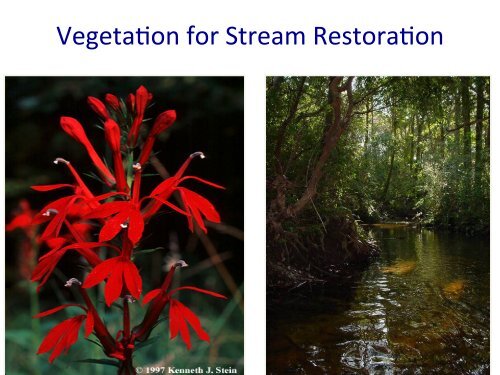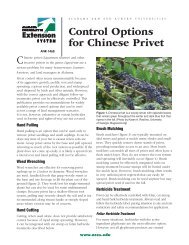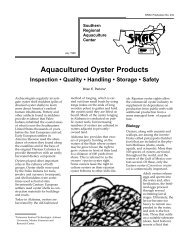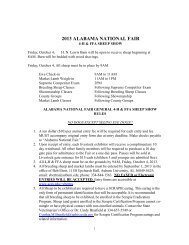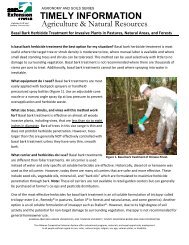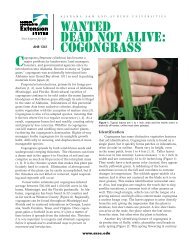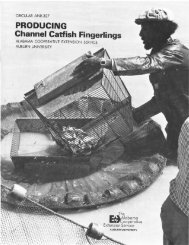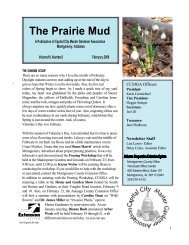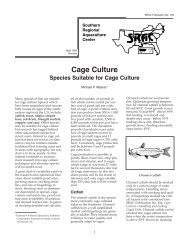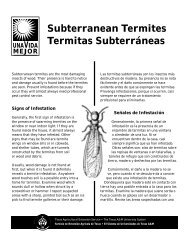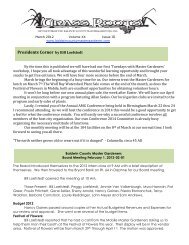Vegetation for Stream Restoration - Alabama Cooperative Extension ...
Vegetation for Stream Restoration - Alabama Cooperative Extension ...
Vegetation for Stream Restoration - Alabama Cooperative Extension ...
You also want an ePaper? Increase the reach of your titles
YUMPU automatically turns print PDFs into web optimized ePapers that Google loves.
Vegeta&on <strong>for</strong> <strong>Stream</strong> Restora&on
Riparian vegeta&on<br />
influences in-‐stream life<br />
• Shading<br />
• Temperature<br />
• Food sources <strong>for</strong> aqua&c<br />
animals<br />
• Woody debris<br />
• Bank stability<br />
• Filtering nutrients and<br />
sediments
Shading-‐Temperature
Food sources <strong>for</strong> aqua&c animals
Woody debris
Bank stability
Filtering nutrients and sediments
Plants reduce flooding – and drought<br />
• Slow rain<br />
• Absorb rain<br />
• Store rain<br />
• Link to aquifers
Plants provide terrestrial and<br />
aerial wildlife habitat
The right plants can even<br />
improve human habitat
Variety of natural systems created with the<br />
deposition of sediment onto the floodplain<br />
<strong>Stream</strong> Corridor <strong>Restoration</strong>: Principles, Processes, and Practices, 10/98, by the Federal<br />
Interagency <strong>Stream</strong> <strong>Restoration</strong> Working Group (FISRWG)."
Ini&al<br />
Assessment<br />
• Plant inventory,<br />
– exo&cs, transplants, protected<br />
• Soil characteriza&on<br />
• Wetland delinea&on<br />
• Threatened & endangered species<br />
• Other project constraints?
Planning <strong>for</strong> pre-‐construc&on<br />
• Extent of disturbance<br />
• Vegeta&on assessment<br />
• Conserving and<br />
stockpiling topsoil<br />
• Species selec&on<br />
• Invasive removal
Planning<br />
Extent of restora&on disturbance?
Planning<br />
• Transplants<br />
– Marking and excava&on<br />
– Storage during construc&on<br />
• Topsoil<br />
– Storage during construc&on<br />
• Seeding
Other constraints<br />
• Power lines<br />
– Iden&fy easement<br />
– Confirm species with power company<br />
– Place signs to prevent removal of vegeta&on<br />
• Landowner vision<br />
– Park-‐like vs. Hairy Nature
Planning<br />
• Invasive, exo&c<br />
removal
Invasive, Exo&c<br />
Plants<br />
• Thrive in disturbed<br />
condi&ons<br />
• Low habitat value<br />
• May not be<br />
providing erosion<br />
control
Invasive, Exo&c Management<br />
ü� Mechanical<br />
ü� Chemical<br />
ü� Physical
Invasive, Exo&c<br />
Management<br />
US Forest Service -‐ A management guide <strong>for</strong> invasive<br />
plants in southern <strong>for</strong>ests<br />
www.treesearch.fs.fed.us/pubs/36915<br />
• AL Coopera&ve <strong>Extension</strong> System – Timely<br />
In<strong>for</strong>ma&on Ar&cles<br />
www.aces.edu/anr/crops/haypastweedcontrol.php
Vegeta&on and <strong>Stream</strong><br />
Restora&on<br />
Seeding<br />
Transplants<br />
Live stakes<br />
Bareroot plants<br />
Container plants
Seeding<br />
• Temporary seeding<br />
• Permanent seeding<br />
• Mulch
Prepare the Site<br />
• Apply topsoil where necessary<br />
• Use soil samples to determine pH, fer&lizer needs<br />
• Loosen soil
Temporary seeding<br />
Common<br />
name Scientific Name<br />
Rate<br />
per<br />
Acre Optimal Planting Dates<br />
Mountains Piedmont Coastal Plain<br />
Rye grain Secale cereale 30 lbs Aug. 15-May 15 Aug. 15-May 1 Aug. 15-Apr. 15<br />
Wheat Triticum aestivum 30 lbs Aug. 15-May 15 Aug. 15-May 1 Aug. 15-Apr. 15<br />
German millet Setaria italica 10 lbs May 15-Aug. 15 May 1-Aug. 15 Apr. 15-Aug. 15<br />
Browntop millet Urochloa ramosa 10 lbs May 15-Aug. 15 May 1-Aug. 15 Apr. 15-Aug. 15
Permanent Seed mix<br />
• Wetland<br />
• Cool season grasses<br />
• Warm season grasses
Permanent Seed Mix<br />
• Switchgrass, Panicum virgatum<br />
• Indiangrass, Sorghastrum nutans<br />
• Deertongue, Dichanthelium clandes5um<br />
• Partridge Pea, Chamaecrista fasciculata<br />
• So^ rush, Juncus spp<br />
• Sedges, Carex spp.<br />
Consider different mixtures <strong>for</strong> different areas (moist<br />
vs. upland)
Applica&on<br />
• Broadcast<br />
– seed on soil surface<br />
– hand spreaders or by hand<br />
– ground raked or harrowed be<strong>for</strong>e seeding
Applica&on<br />
• Mulch increases successful seed germina&on:<br />
– provides physical substrate <strong>for</strong> the seeds so they are not blown<br />
or washed off site<br />
– provides physical protec&on <strong>for</strong> the seeds from extremes in<br />
temperature, light, and moisture<br />
– retains moisture<br />
– reduces soil erosion<br />
– Wheat straw, 2 tons / acre<br />
• 75% cover
Applica&on<br />
• Erosion Control Mafng<br />
– Spread seeds be<strong>for</strong>e placing mafng<br />
– Cover with mulch<br />
– Stake mafng into place along streambank
Permanent Seed Calcula&ons<br />
• 12-‐15 pounds per acre, pure live seed, broadcast
Trees and shrubs<br />
• Bare root, container, transplants, live stakes<br />
• Number planted may depend on requirements (mi&ga&on),<br />
project goals, aesthe&cs, etc.<br />
Type Spacing # per 1,000 sq ft<br />
Shrubs ( 25 ft) 8-15 ft 4 - 15
Transplants<br />
• Take advantage of na&ve vegeta&on on site with the<br />
equipment you have on site<br />
• Get as large a rootball as you can (2’ – 3’ of soil)<br />
• Plant as soon as possible … may create a wai&ng area<br />
<strong>for</strong> plants
Transplants<br />
• Look <strong>for</strong> small shrubs & trees up to 3 inches in<br />
diameter<br />
• Sycamore, Alder, Elderberry, and Spice Bush all<br />
respond well as transplants<br />
• Plant at bankfull eleva&on<br />
or above<br />
• Start in cri&cal areas along<br />
meander bends or near<br />
in-‐stream structures
Transplants<br />
• Wetland plants transplant well – Carex, Juncus<br />
• Collect marsh vegeta&on from nearby area (don’t<br />
ransack it)<br />
• Keep transplants moist and plant as soon as possible
Live Stakes<br />
• A dormant hardwood s&ck,<br />
pushed into wet/moist soil<br />
• Best planted in dormant<br />
season<br />
• Not likely to be washed<br />
away<br />
• 0.5 – 2” in diameter, 2’ –<br />
3’ long<br />
• Keep moist, soak in water<br />
<strong>for</strong> 24 hours
Live Stakes<br />
• Install 2 to 4 feet apart using<br />
triangular spacing<br />
• Drive stakes into the ground using<br />
a rubber hammer – may have to<br />
use leader (rebar)<br />
• At least 2 buds should remain<br />
above ground<br />
• Green side up … cut bolom at an<br />
angle
Live Stake Species<br />
Salix nigra, Black Willow<br />
Cornus amomum, Silky Dogwood<br />
Salix sericea, Silky Willow<br />
Physocarpus opulifolius, Ninebark<br />
Platanus occidentalis, Sycamore<br />
Sambucus canadensis, Elderberry<br />
Itea virginica, Virginia sweetspire
Bioengineering<br />
• Brush malress
Bare Root Seedlings<br />
• Bare root seedlings dug<br />
and stored without soil<br />
around their roots<br />
• Missing >90% of root<br />
hairs - plant’s water<br />
absorbing structures<br />
• Keep plants moist and<br />
cool
Bare Root Seedlings<br />
• Ideal to plant when<br />
vegeta&on is dormant, winter<br />
or early spring<br />
• Benefits –<br />
– less expensive,<br />
– don’t need much exper&se to<br />
plant (green side up),<br />
– may be more diverse nursery<br />
selec&on<br />
• Drawbacks –<br />
– may experience higher mortality<br />
than container plants,<br />
– purchase 10 – 15% more than<br />
needed, plant addi&onal plants<br />
in holding area
Plan&ng Bare Roots<br />
1. Carefully remove loose<br />
packing material (peat<br />
moss, sawdust).<br />
2. Soak roots<br />
3. Trim away moldy,<br />
poor condi@on roots<br />
4. Dig a hole deep and<br />
wide<br />
5. Cover roots with soil<br />
and press down firmly.<br />
Root collars of<br />
seedlings should be<br />
slightly below soil<br />
surface<br />
6. Make sure all roots -‐<br />
especially those under<br />
the crown -‐are in<br />
contact with soil.<br />
Be<strong>for</strong>e planting,<br />
soak 5-10 minutes<br />
– 4 hours, but not<br />
over 24 hours
Container Plants
Container Plants<br />
• Benefits:<br />
– well established root system,<br />
– may have higher survivorship<br />
than bare root,<br />
– can be planted just about any<br />
season<br />
– Instant tree or shrub<br />
• Drawbacks:<br />
– expensive,<br />
– requires more labor in plan&ng
Plant Selec&on<br />
• Na&ve Plants<br />
• Water Tolerance<br />
• Light Tolerance<br />
• Compa&ble with Soils<br />
• Wildlife Value<br />
• Aesthe&cs<br />
What are the goals?
Water Tolerance<br />
• Hydrophytes – water loving plants<br />
• Have physiological and morphological traits that promote<br />
survival in flooded soil condi&ons<br />
• Important to match plants with appropriate zone of<br />
inunda&on (don’t want to drown them)
Wetland Indicator Status<br />
Code Wetland Type Comment<br />
OBL Obligate Wetland Occurs almost always (es&mated probability 99%)<br />
under natural condi&ons in wetlands.<br />
FACW Faculta&ve<br />
Wetland<br />
Usually occurs in wetlands (es&mated probability<br />
67%-‐99%), but occasionally found in non-‐wetlands.<br />
FAC Faculta&ve Equally likely to occur in wetlands or non-‐wetlands<br />
(es&mated probability 34%-‐66%).<br />
FACU Faculta&ve Upland Usually occurs in non-‐wetlands (es&mated probability<br />
67%-‐99%), but occasionally found on wetlands<br />
(es&mated probability 1%-‐33%).<br />
UPL Obligate Upland Occurs almost always (es&mated probability 99%)<br />
under natural condi&ons in non-‐wetlands
Zone 5 OBL<br />
Zone 1 OBL<br />
Zone 3 FACW, FAC<br />
Zone 2 OBL, FACW<br />
Zone 4 FAC, FACU
Light Tolerance<br />
• Plants will at first be exposed to high levels of sunlight<br />
(if large shade trees are absent)<br />
• Consider ability of plant to withstand full sun condi&ons – select<br />
plants that won’t get ‘burned up’<br />
• Take advantage of shade trees present to diversify planted<br />
species <strong>for</strong> future poten&al seed bank
Plant Name Water Tolerance Light Tolerance<br />
Acer rubrum, Red Maple � � �<br />
Iris versicolor, Blue Flag<br />
Iris<br />
� � �<br />
Juncus effusus, Soft Rush � � �<br />
Cercis canadensis,<br />
Redbud<br />
Magnolia virginiana,<br />
Sweetbay magnolia<br />
Ilex vomitoria, Yaupon<br />
Holly<br />
dry soils - �<br />
� � �<br />
dry soils - � �
Regional Considera&ons<br />
• Mountains, Piedmont, Blackbelt, Coast<br />
• Many na&ve plants in <strong>Alabama</strong> will fair well across the<br />
state …<br />
• Be aware of plants that will only thrive in certain regions<br />
– Blackbelt prairie alkaline clay soils<br />
– Coastal sandy soils
Vegeta&on Examples<br />
Depends on your region …<br />
• Trees – River Birch, Cypress, Black Gum, Sycamore,<br />
Black Willow, Silky Dogwood, Sweet Bay Magnolia
Vegeta&on Examples<br />
Depends on your region …<br />
• Shrubs / Small Trees – Tag Alder, Common Paw Paw,<br />
Spicebush, Yellow Root, Bulonbush, Wax Myrtle, Itea,<br />
Viburnum
Vegeta&on Examples<br />
Depends on your region …<br />
• Herbaceous – Jack in the pulpit, Cardinal flower,<br />
Switchgrass, Woolgrass, Blue Flag Iris
Loca&ng Plants<br />
• Purchase from reputable nurseries<br />
• Best to get local stock -‐ greater wildlife benefit and beler adapted<br />
to local clima&c condi&ons<br />
• May have to work with several nurseries to get the plant diversity<br />
you wish<br />
• Some nurseries prefer wholesale only, so make arrangements with<br />
local nurseries <strong>for</strong> purchase & delivery<br />
• Plan early or be flexible
Check around and see which<br />
planting type best suits your<br />
budget:<br />
• bare root<br />
• plugs<br />
• container
<strong>Stream</strong> <strong>Restoration</strong> Sites<br />
• <strong>Stream</strong> construction sites = harsh conditions<br />
• Soil<br />
– Compacted<br />
– Little or no organic matter<br />
– Full sunlight ( ê� soil moisture)<br />
– Water supply?
How can we improve vegetation establishment<br />
<strong>for</strong> stream restoration?<br />
• Consider a mixture of larger trees and shrubs<br />
– 1 - 3 gallon container plants<br />
– Initial purchase price is higher, but they work<br />
• Fertilize planting hole<br />
• Match water and sun<br />
tolerance<br />
• Minimize compaction
Vegeta&on Alributes<br />
Incorporate trees, shrubs, grasses and <strong>for</strong>bs to protect waterways<br />
and diversify habitat<br />
Stabilize Bank Erosion<br />
Filter<br />
Sediment & Nutrients (bound)<br />
Soluble Nutrients, Pesticides,<br />
Microbes<br />
Aquatic Habitat<br />
Wildlife Habitat<br />
(<strong>for</strong>est wildlife)<br />
Flood Protection<br />
Benefit Grass Shrub Tree<br />
Adapted from Agro<strong>for</strong>estry Notes. AF Note-4, Jan. 1997. USDA/NRCS<br />
Low / Medium Medium / High High<br />
High<br />
Medium<br />
Low<br />
Low<br />
Low<br />
Low / Medium<br />
Low<br />
Medium<br />
Medium<br />
Medium<br />
High<br />
Medium<br />
High<br />
High<br />
High
Considering<br />
Your<br />
Vegeta&on
Plant Protec&on
Maintenance<br />
Visit site o^en …<br />
ü� Replace dead plants<br />
ü� Remove invasive, nonna&ve plants<br />
ü� Browsing (or weed-‐whackers)<br />
ü� Communica&on – please stop mowing our plants<br />
ü� Planning thought -‐ Has money been budgeted <strong>for</strong><br />
vegeta&on maintenance?
Vegeta&on Resources<br />
• TVA Na&ve Plant Selector<br />
hlp://www.tva.gov/river/landandshore/stabiliza&on/plantsearch.htm<br />
• USDA Plant Database<br />
hlp://plants.usda.gov/<br />
• Na&onal Na&ve Plant Nursery Selector<br />
hlp://www.plantna&ve.org/na&onal_nursery_dir_main.htm


